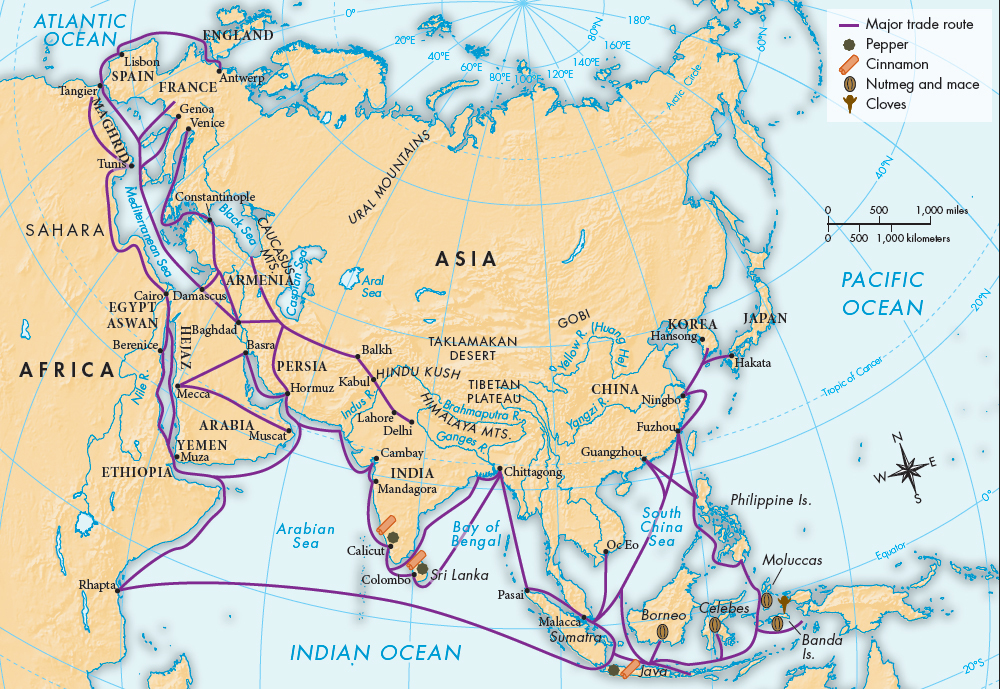A History of World Societies:
Printed Page 352
Global Trade
Spices were a major reason from ancient times on for both Europeans and Chinese to trade with South and Southeast Asia. Pepper, nutmeg, cloves, cinnamon, and other spices were in high demand not only because they could be used to flavor food but also because they were thought to have positive pharmacological properties. Unlike other highly desired products of India and farther east — such as sugar, cotton, rice, and silk — no way was found to produce the spices close to where they were in demand. Because of the location where these spices were produced, this trade was from earliest times largely a maritime trade conducted through a series of middlemen. The spices were transported from where they were grown to nearby ports, and from there to major entrepôts, where merchants would take them in many different directions.
Two types of pepper grew in India and Southeast Asia. Black pepper is identical to our familiar peppercorns. “Long pepper,” from a related plant, was hotter. The Mediterranean world imported its pepper from India; China imported it from Southeast Asia. After the discovery of the New World, the importation of long pepper declined, as the chili pepper found in Mexico was at least as spicy and grew well in Europe and China.
By Greek and Roman times trade in pepper was substantial. According to the Greek geographer Strabo (64 B.C.E.–24 C.E.), 120 ships a year made the trip to India to acquire pepper, the round trip taking a year because sailors had to wait for the monsoon winds to shift direction. Pliny in about 77 C.E. complained that the Roman Empire wasted 50 million sesterces per year on long pepper and white and black pepper combined.

Cloves and nutmeg entered the repertoire of spices somewhat later than pepper. They are interesting because they could be grown in only a handful of small islands in the eastern part of the Indonesian archipelago. Merchants in China, India, Arab lands, and Europe got them through intermediaries and did not know where they were grown. An Arab source from about 1000 C.E. reported that cloves came from an island near India that had a Valley of Cloves, and that they were acquired by a silent barter. The sailors would lay the items they were willing to trade out on the beach, and the next morning they would find cloves in their place.
The demand for these spices in time encouraged Chinese, Indian, and Arab seamen to make the trip to the Strait of Malacca or east Java. Malay seamen in small craft such as outrigger canoes would bring the spices the thousand or more miles to the major ports where foreign merchants would purchase them. This trade was important to the prosperity of the Srivijayan kingdom. The trade was so profitable, however, that it also attracted pirates.
In the Mongol era, travelers like Marco Polo, Ibn Battuta, and Odoric of Pordenone (in modern Italy) reported on the cultivation and marketing of spices in the various places they visited. Ibn Battuta described pepper plants as vines planted to grow up coconut palms. He also reported seeing the trunks of cinnamon trees floated down rivers in India. Odoric reported that pepper was picked like grapes from groves so huge it would take eighteen days to walk around them. Marco Polo referred to the 7,459 islands in the China Sea that local mariners could navigate and that produced a great variety of spices as well as aromatic wood. He also reported that spices, including pepper, nutmeg, and cloves, could be acquired at the great island of Java, perhaps not understanding that they had often been shipped from the innumerable small islands to Java.
Gaining direct access to the spices of the East was one of the motivations behind Christopher Columbus’s voyages. Not long after, Portuguese sailors did reach India by sailing around Africa, and soon the Dutch were competing with them for control of the spice trade and setting up rival trading posts. Pepper was soon successfully planted in other tropical places, including Brazil. India, however, has remained the largest exporter of spices to this day.